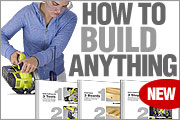Pilot Holes & Countersink Bits
Most of the problems related to driving screws have nothing to do with the screw itself, but everything to do with the pilot hole (or lack of). Wood screws are too large to be forced into a board without some type of path to lead the way. Although they’re tempting to ignore, pilot holes can mean the difference between project success—or project disaster.
What Size Pilot Hole Should I Drill?
As a general rule, a pilot hole should be the same diameter as the root of the screw—the area just below the threads. This allows the bulk of the screw to easily enter a board without splitting the grain, while the threads do all the work of pulling two boards together to form a joint.
A Better Fit
A simple pilot hole might be fine for the threaded portion of the screw, but it won’t provide any space for the head or the shank (see photo right). The solution is to use a countersink bit, which creates both a pilot hole for the threads, and a larger hole for the head and shank.
Tapered or Straight?
Some screws have a shank that is wider than the threaded portion of the screw. That’s when I like to use a tapered countersink to get the best fit. For screws that have a more narrow shank, I like to use a straight countersink bit.
Stop Fighting Screws
There’s nothing more frustrating than having to fight wood screws during the final stages of a wood project. Screws can be unpredictably stubborn—causing a host of problems in bringing two boards together. The good news is that most of the trouble with driving screws can be blamed on just a few culprits—things that can be easily avoided if you correctly prepare a board for the joint. See the chart to the right learn more.
Top 3 Problems Driving Screws
1. Stalled Screw
Here’s where the screw seems to be going in, but suddenly stops short. You can try pushing harder, but you might end up stripping the head—or worse, splitting the board.
Possible Culprit
• No pilot hole
• Pilot hole too small
Cure
Carefully back the screw out of the board. Then test a larger size pilot hole on scrap wood. In most cases, it’s the shank of the screw that’s being stubborn—which can easily fixed by using a tapered countersink bit to make a new pilot hole.
2. Over-Drive
This is an easy mistake to make with soft wood like pine. The big problem here is that your wood screw can easily break through the other side of the board you are attaching to.
Possible Culprit
• Drill torque set too high
• Pilot hole too large
Cure
Unfortunately, getting the right size pilot hole means you can easily drive a screw too far in—if you’re not careful. That’s where the adjustable torque clutch on your driver comes to the rescue Also check that your pilot hole is not too large for the screw.
3. Bridging
Sometimes a wood screw can force apart the two boards you are trying to join. Unfortunately, you might not notice the problem till you’ve moved on to another part of the project.
Possible Culprit
• Boards are warped
• Splinters are blocking joint
Cure
Slightly warped boards can leave a gap in the joint. An easy fix is to clamp the boards together before driving screws. Pilot hole splinters can be cured by drilling a countersink in the adjoining board—to keep the splinters from blocking the joint.
|

